Picking up a cat means lifting the animal and holding it correctly so as not to cause the cat discomfort or distress.
To pick up your cat, approach calmly, lift your pet gently, support her body, speak softly to your cat, and always pay attention to any signals your furry friend gives that tell you she doesn’t want to be picked up.
Hold your cat by placing one hand under the cat’s body and the other under her hindquarters for support, gently lift her up, and hold her firmly against your chest, so she knows she won’t fall.
Most cats like to be held, but some don’t. That’s usually because the cat feels vulnerable when her feet are off the ground, and she cannot flee if necessary. However, with some patience and positive reinforcement training, most of our furry friends will accept being picked up and held by their doting owners!
If you want to learn how to cuddle your cat the right way, keep reading this comprehensive guide!
Do Cats Like Being Picked Up?
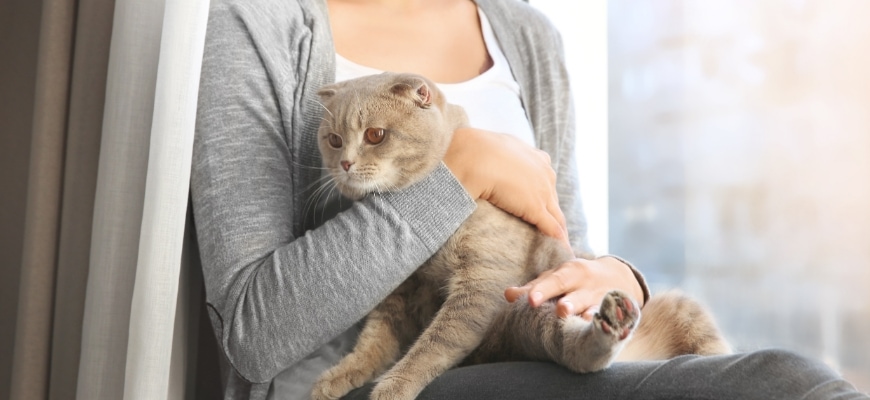
That depends on the cat! Cats’ preferences for being picked up vary depending on each cat’s personality and early experiences.
Some cats enjoy the closeness and affection of being held, especially if they are regularly and gently handled as kittens. However, others find the act constraining or threatening and prefer keeping their feet on the ground.
It’s essential to pay attention to your cat’s body language and reactions to understand her personal preferences. If your cat shows signs of discomfort or stress when being lifted, it’s best to respect her boundaries and let her keep all four paws on the ground.
Socialization
Socialization is how cats become accustomed to and comfortable with certain experiences and environmental stimuli. If your cat is gently handled from kittenhood, she is far more likely to be comfortable with being picked up and held. However, cats that were not well socialized early in their lives might find being picked up stressful and even frightening.
Personality
Just like humans, cats have individual personalities. Some are naturally more tolerant, confident, and affectionate than others making them more accepting of being picked up. Others might be more independent or skittish and might not appreciate being handled, so recognizing and respecting each cat’s boundaries and preferences is essential.
Previous Experiences
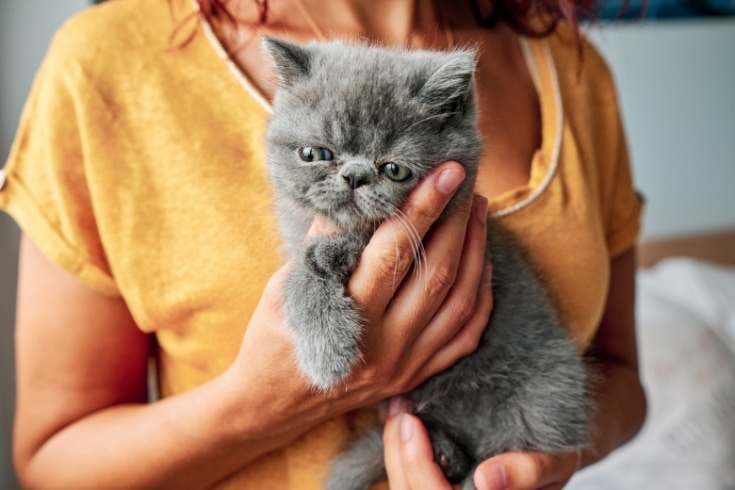
If a cat has had negative experiences with being lifted, like being held too tightly, being picked up suddenly, or being in pain, she might not be too keen on the idea. On the other hand, cats that have always had pleasant, gentle experiences when being picked up will likely be more receptive to the idea.
Health and Comfort
A cat’s physical well-being can significantly affect her willingness to be picked up. If the cat is in pain or discomfort from injury, arthritis, or other health issues, she probably won’t want to be handled simply because it hurts. Additionally, if a cat feels trapped or uncomfortable in how it’s being held, she might be resistant in the future.
Trust and Bond
Cats with strong bonds and trust with their humans are likelier to feel safe and secure when picked up. When a cat trusts the person handling her, she’s more likely to relax and even enjoy the experience. But building trust takes time and consistency, and it’s essential always to handle cats gently and respect their boundaries.
What Are the Signs That a Cat Does Not Want to Be Picked Up?
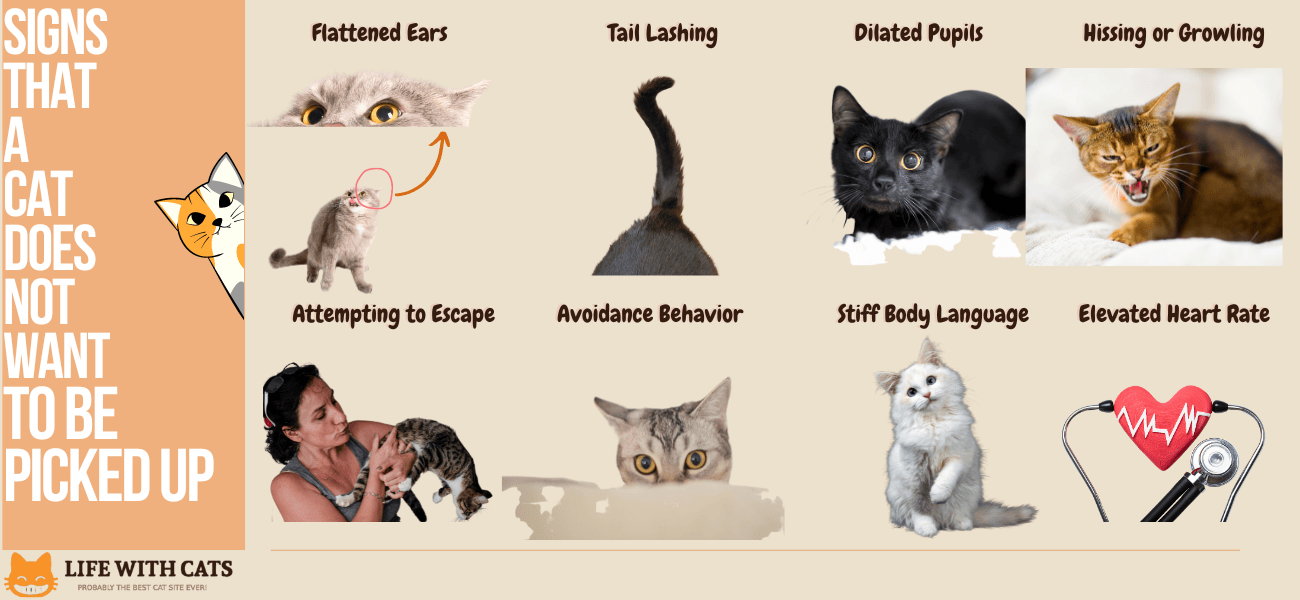
The signs are clear when a cat doesn’t want to be picked up, and you must learn to recognize them if you want to avoid getting scratched or distressing your feline friend.
Here’s an overview of some common signs that a cat does not want to be picked up.
Flattened Ears
If the cat flattens her ears against her head, that is usually a sign of anxiety and fear, clearly indicating that the kitty doesn’t want to be picked up off the ground.
Tail Lashing
Tail lashing is a physical sign that cats exhibit when angry or frightened, and trying to pick up a cat that is thrashing its tail from side to side is asking for trouble!
Dilated Pupils
A cat’s pupils dilate in response to a sudden increase in adrenaline levels in the muscles that control the eye. If your cat’s pupils are dilated, that is a clear sign that she is in fight or flight mode and doesn’t want to be picked up or handled.
Hissing or Growling
Most people know that when a cat hisses or growls she is not in the mood for cuddling and petting and most certainly does not want to be picked up and held. Hissing or growling is a sign of aggression and anxiety and if your cat vocalizes in that way, it’s best to let her be.
Attempting to Escape
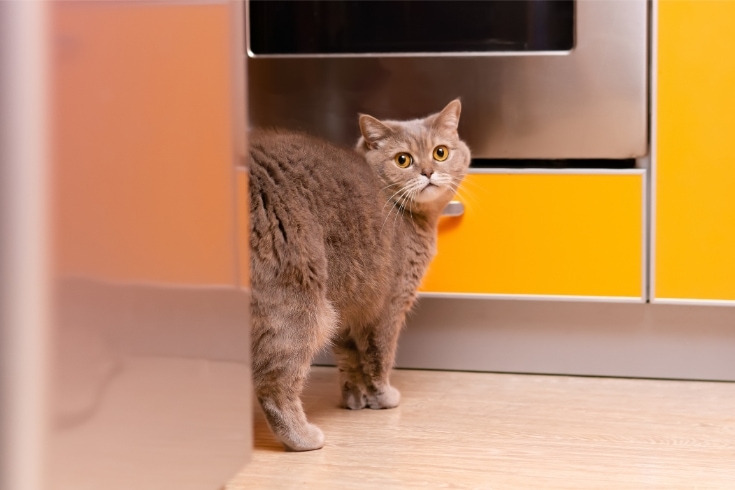
When a cat is anxious or alarmed, she will probably wriggle around and attempt to escape if you try to pick her up and hold her. In that case, don’t persist or you will frighten your cat even more. The best thing to do if your cat tries to escape is to simply let her go, provided it’s safe to do so.
Avoidance Behavior
A cat that doesn’t want to be picked up will do her best to avoid you by hiding or simply running away. Avoidance behavior can also include refusing to make eye contact and looking away from you when you approach. Again, if your cat tries to avoid you, she clearly does not want to be picked up, and the best thing to do is let her be.
Stiff Body Language
Rather like a human baby that doesn’t want to be put in a stroller, a cat that doesn’t want to be picked up will often stiffen her body against you, making it more difficult for you to take control of her.
Sometimes, stroking and petting the cat will encourage her to relax and soften her body against you, so that is worth a try if your cat exhibits stiff body language.
Elevated Heart Rate
An increased heart rate is a cat’s response to a situation that frightens her. Basically, the heart beats faster to pump more blood around the body, providing the muscles with the energy they need for flight or fight.
Again, you could try to relax your cat by stroking her gently and talking to her reassuringly, helping to reduce her heart rate. Once your pet is more chilled, try picking her up gently.
Can You Train A Cat To Like Being Held?
Yes, it’s possible to train a cat to like being held. However, first, you need to know why the cat being held stresses her so much. Once you’ve worked out why my cat doesn’t like to be held, you can start training her.
How to Get Cats to Like Being Held
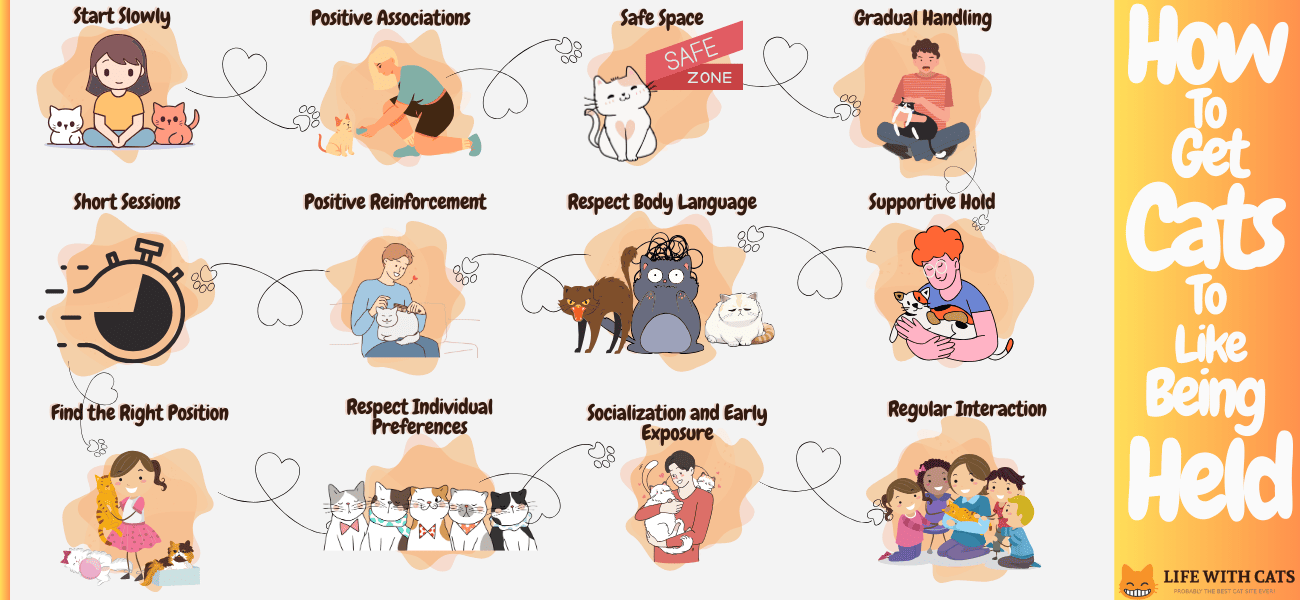
So, how do cats like to be held? That’s essential to know if you want to train your cat to enjoy being cuddled and held.
Here’s a detailed overview of how you can get your cat to like being held.
Start Slowly
Don’t be in too much of a rush to persuade your cat to enjoy being held. It really is a case of “slowly, slowly, catchy, monkey” when it comes to training cats to like being held and picked up!
Set aside plenty of time for your training sessions so that you can take your time and not hurry.
Positive Associations
For your cat to enjoy being held, you will need to create positive associations for her with that experience. For example, when your cat tolerates you picking her up and holding her, give her a treat or a game with a favorite toy as a reward. That way, your cat learns to associate being held with something enjoyable and will be more likely to tolerate it in the future.
Safe Space
Create a safe space in your home for your training sessions where you and your cat cannot bump into anything or come to harm. For example, choose an uncluttered room without lots of ornaments on low tables and hiding places your cat could retreat to.
Gradual Handling
Take your time when getting your cat used to being handled. Rushing to grab your cat is a surefire way of frightening her and creating negative associations that could stay with her for life. So, allow plenty of time for your training sessions, and start by petting your cat all over before you try to pick her up and hold her.
Supportive Hold
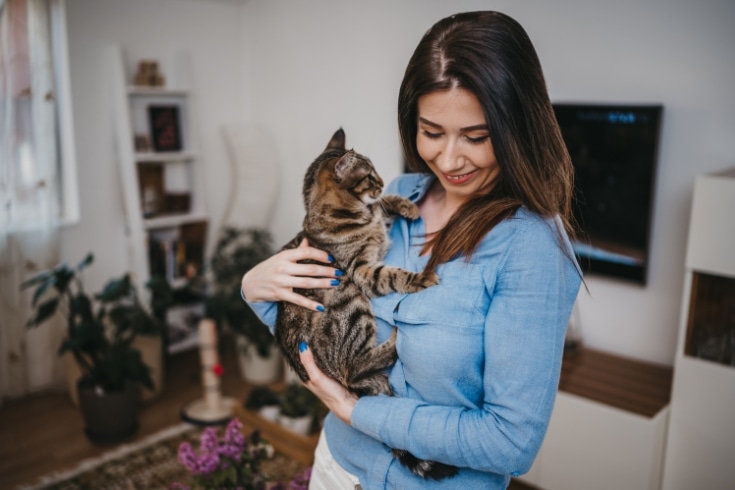
Your cat won’t want to be held if she thinks you’re going to drop her, so be sure to support her body weight and put one hand underneath her hindquarters so that your pet feels safe in your arms.
Respect Body Language
As mentioned earlier, cats show distinct physical symptoms to indicate stress, anxiety, and fear. If you notice any of those signs in your cat’s body language, back off and be prepared to start the training session again when your pet’s body language is more positive.
Positive Reinforcement
In all your training sessions, use positive reinforcement reward-based techniques. Positive reinforcement means rewarding your cat with a treat, a game with a favorite toy, or a fuss immediately after she does something good.
For example, when your cat allows you to hold her without struggling, tensing her body, or otherwise showing displeasure, be ready to give her a treat and verbally praise her for being such a good girl.
Short Sessions
Cats have quite a short attention span, so keep your training sessions short and sweet. That’s especially important if your cat gets stressed when you pick her up and hold her. Try to end every training session on a positive note and consider including two or three short sessions throughout the day.
Find the Right Position
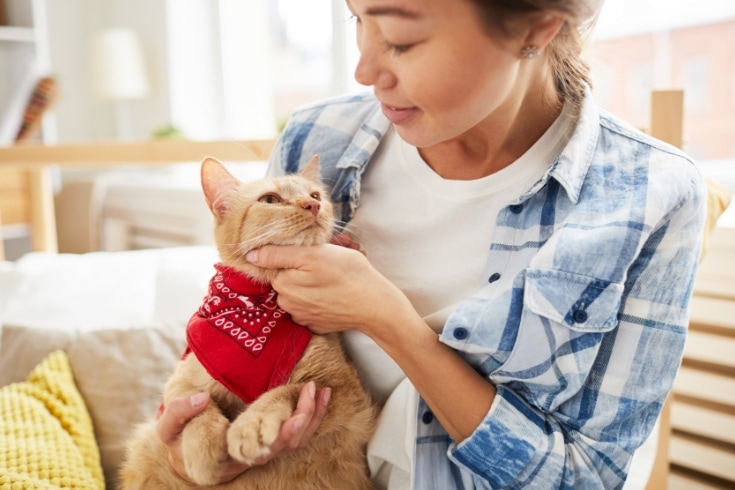
When holding your cat, be sure to get her settled in a comfortable position where she feels safe and secure. It’s essential that your cat knows you won’t drop her and she doesn’t feel that she’s being squashed or strangled in your arms!
Respect Individual Preferences
Every cat is different, so be sure to get to know your feline friend’s individual preferences, so allow your cat the freedom to fidget and get comfortable when you hold her.
For example, one of my cats loves to sit draped over my arm with his legs on either side, whereas the other prefers to be wrapped in my arms with her paws over my shoulder.
Socialization and Early Exposure
If you have your cat from kittenhood, be sure to socialize her early in her life so that she gets accustomed to being picked up and held. Most cats enjoy human contact and connection, but most resistance comes from older kitties who’ve never been “loved” before.
Regular Interaction
Just like any training exercise, regular interaction with your cat can ensure that she won’t forget her training, and that’s especially important if your cat was reluctant to be held to begin with. Essentially, the more you cuddle your cat and show her that interacting with you is nothing to be afraid of and is actually quite enjoyable, the better. So, make a point of holding your cat and petting her in your arms at least once every single day.
How Do You Pick Up A Cat?
To properly pick up a cat, you need to approach her calmly, assess her mood, and begin by offering your hand for her to sniff. Don’t start by picking up the cat and hoping for the best, especially if the cat is not known to you!
Here’s an overview of how to pick up a cat.
Approach Calmly
Start by approaching the cat calmly and talking to her softly and in reassuring tones. Don’t simply try to grab the poor creature! That will probably simply frighten the cat and cause her to run away.
Assess The Cat’s Mood
Observe the cat’s body language to see whether she appears receptive and relaxed. If the cat’s pupils are dilated, she is thrashing her tail, or her ears are pinned back against her head, step away from the kitty, or you could be attacked!
If the cat appears relaxed and calm, is purring, and offers you a head bump, those are all signs that your pet is in a good mood and ready to be picked up.
Offer Your Hand
Offer your hand to your cat to sniff. Cats are highly scent-oriented with a much keener sense of smell than ours, and it’s important that your cat gets to know your scent. With luck, your pet will rub her face against your hand to leave her own scent there. That will give her confidence when you try to pick her up because she has marked you as her territory.
Pet And Stroke
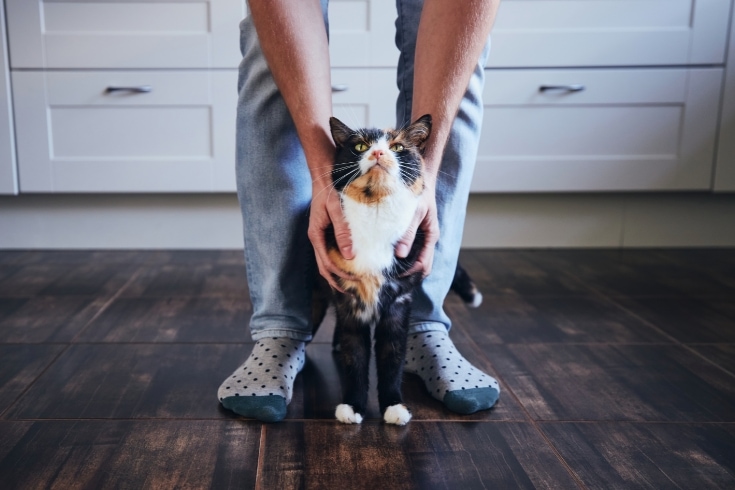
Before you try to pick up your cat, take a few minutes to pet and stroke her. That helps to relax your pet and get her comfortable before you try to lift her off the ground.
Position Yourself Correctly
You must position yourself correctly to pick up your cat so that you don’t hurt her or, even worse, drop her! Always use two hands to pick up your cat or kitten.
Position yourself slightly behind or next to your cat. Place your outer arm beneath your cat’s chest and belly with the other hand in front of her on her chest so that you have control of the cat’s front legs. Now, lift the cat, keeping her parallel to the ground. Keep the cat facing away from you and in your direction of travel.
Support The Body
To give your cat a safe, secure feeling, slide a flat hand along the side of your cat’s body, then move it under the chest, placing your hand between her front paws. Slide your other hand under the cat’s backside to support her, and once she is comfortable and secure, bring your pet’s body close to your chest.
Lift Gently
With your cat’s body fully supported, lift her gently, taking care not to jolt or pull her joints. Remember that every part of the lifting and holding experience must be pleasant for your pet, or she will quickly start resenting you.
Speak Softly
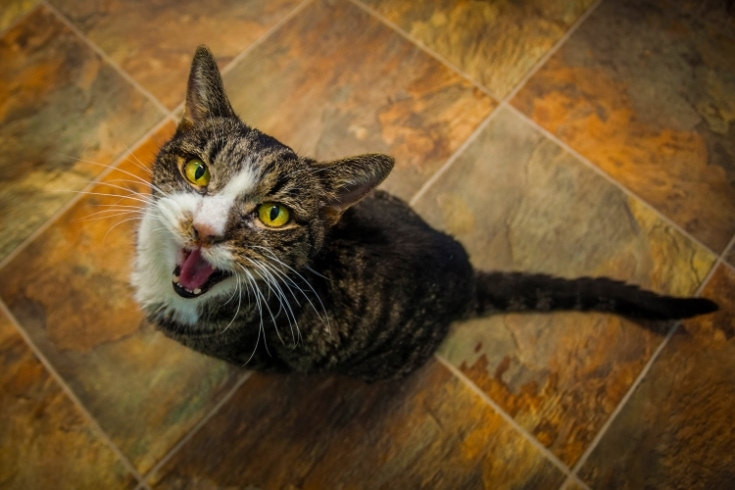
Throughout the exercise, speak softly to your cat and reassure her that everything’s okay and she’s being a very good girl. Don’t become impatient and use a harsh tone when speaking to your cat, as that could frighten her and make her anxious about being picked up.
Pay Attention To Signals
Pay attention to any signals your cat gives you that she is feeling uncomfortable, distressed, or anxious. If your cat tenses her body, pins back her ears, or tries to escape, those are signals that she’s not happy.
Don’t persist in hanging onto your cat if she’s unimpressed with the idea of being picked up and held. That will only exacerbate the problem and create a negative association for your cat, so it’s best to put her down on terra firma and try again later.
How Do You Properly Hold A Cat?
To properly hold a cat, ensure that she’s well supported, and don’t let her legs dangle if you’re holding her in your arms. It can work well to place your hand gently on your pet’s back so that she feels more secure and to help keep her in place.
When it comes to how to hold a cat on the examination table at the vet clinic, use the minimum amount of restraint possible. Hold the cat’s shoulders to stop her from escaping, but ensure she can move her body, head, and legs. How to hold a kitten is much the same, although that’s usually easier since a kitten is much smaller and not as strong as an adult cat.
How to carry a cat is to use a carrier if you think she might get anxious and start struggling. That’s safer for you and your pet and creates a more positive experience for both of you.
Here’s a brief guide on how to properly hold a cat.
Be Aware of Body Language
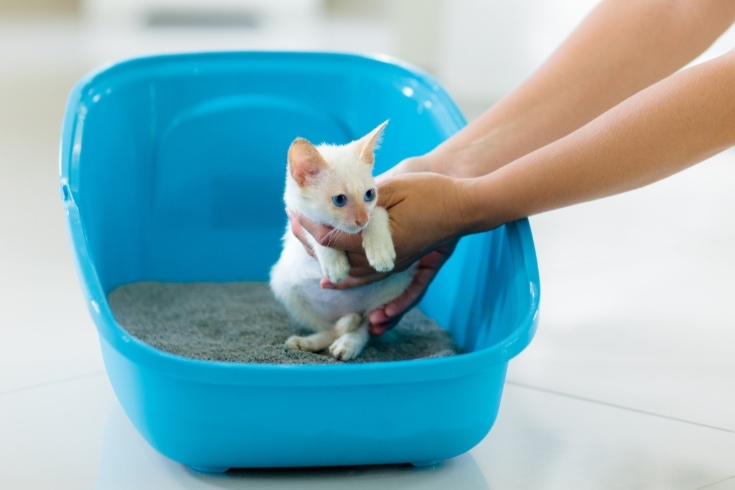
Be aware of your cat’s body language at all times. There’s no point trying to pick up and hold your cat if she’s anxious or worried, so if your cat appears tense and stiffens against you, take some time to stroke and pet her until she relaxes.
Ideally, you want your cat to purr as you get closer to her, telling you she’s happy to see you and most likely to stay relaxed when you pick her up.
Let Your Cat Know You’re There
Cats are easily startled, so it’s important your pet knows you’re there before you try to hold her. Let your cat sniff your hand, touch her gently on her back, and talk to her softly, telling her you are going to pick her up and hold her.
Avoid Sensitive Areas
Avoid touching any sensitive areas on your cat, such as her belly and anywhere else you know she hates being touched.
Place One Hand Under The Cat’s Body
Position one hand beneath your cat’s chest or stomach and the other under her legs. Ensure your grip on the cat’s chest, front, and back legs is secure but gentle, preventing any sudden movements or attempts to escape.
Place The Other Hand Under The Cat’s Hindquarters
Place your other hand under the cat’s hindquarters, and don’t leave her back end dangling, which could be extremely uncomfortable for your pet.
Gently Lift The Cat
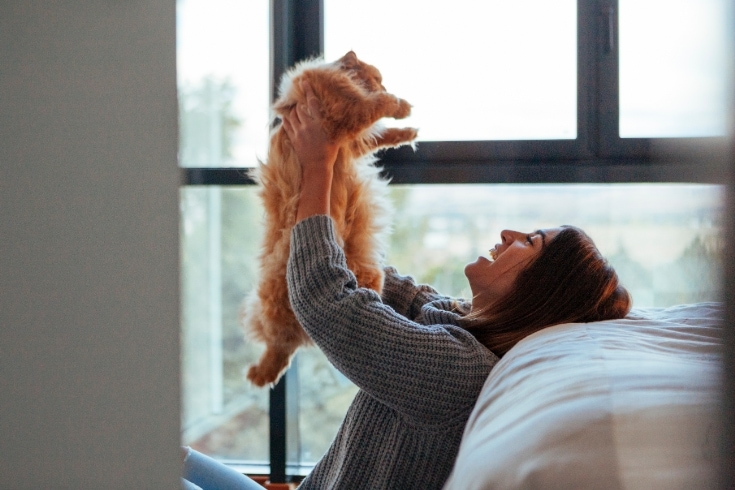
Lift your cat gently but confidently, using steady and reassuring motions so that she can feel your stability and know you won’t drop her.
Hold The Cat Against Your Chest
Lift the cat and hold her against your chest in a snug embrace. Holding your pet close to your body gives a sense of security, but don’t squeeze your feline friend too tight, and allow her to look around her environment so that she doesn’t feel trapped and constrained.
How Do You Put Down A Cat?
Having picked your cat up, you now need to know how to put a cat down and when to put a cat down again.
To safely put down a cat on the ground again, allow him to place his front paws on the floor or some other solid surface, supporting your pet’s hind end as she steps down from your arms. If the cat starts to struggle, don’t fight to keep hold of him; instead, try to get low to the ground and allow your cat to hop down safely.
Know When The Cat No Longer Wants To Be Held
If the cat stiffens against you, pulls away, or starts struggling, you know she’s had enough and wants to get down.
Gently Place The Cat Down
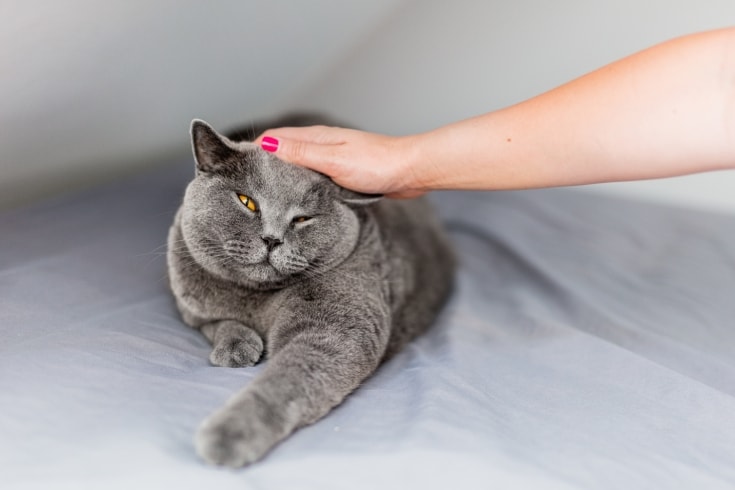
Don’t just drop your cat from a height or allow her to jump from your arms! That could result in injury to your pet or damage to something in your home if the kitty lands on a coffee table full of fragile ornaments.
Instead, gently lower the cat down to the floor and set her down gently.
Do Not Scruff The Cat
Never grab your cat by the scruff of the neck! Although mother cats carry their kittens that way, you shouldn’t do it.
A full-grown cat is too heavy to be scruffed, and you could injure her or leave her with a negative experience that could set back your training efforts.
Make Sure A Child Has Close Supervision While Picking Up A Cat
Kids are smaller and not as strong as adults and could easily hurt your cat when picking her up. If the cat is uncomfortable, she could scratch the child and be reluctant to be held in the future.
If you must allow your children to pick up and hold your cat, always do so under close supervision and make it clear that they must not try to lift their furry friend unless you’re there to help.
FAQs
In this part of our guide, we answer some of the most commonly asked questions on picking up and holding a cat.
Can All Cats Be Picked Up Using The Same Technique?
Yes, most cats can be picked up using the technique described above. However, every cat has a unique temperament and preferences, and what works for one might not work for another.
It’s essential to be attuned to your cat’s body language and comfort level, so with time and patience, you’ll learn the best lifting and holding technique for your feline friend.
Which Cat Breeds Tend To Enjoy Being Held The Most?
While all cats have their unique personalities and preferences, some breeds, such as Ragdolls, Scottish Folds, and Birman cats, are generally more sociable and enjoy human interaction, including being held. However, it’s important to note that individual personalities can vary and override those generic breed tendencies.
How Can I Calm Down A Cat Before Attempting To Pick Them Up?
Approaching a cat calmly and quietly before picking her up is important. You can try speaking in soft tones and offering gentle pets if she seems open to that kind of attention, and familiar activities like giving treats or playing can also help a tense cat to relax. Ensure the cat sees you coming and avoid sudden or quick movements that frighten or spook her.
Are There Risks Associated With Holding A Cat Incorrectly?
Yes, holding a cat incorrectly can lead to injury for both you and the cat.
If the cat is not supported properly, she could wiggle free or use her claws and teeth defensively. In addition, forcing a cat to stay in a hold she finds uncomfortable can damage your bond of trust.
What’s The Best Way To Carry A Cat Without Startling Them?
When picking up a cat, approach them calmly and slowly. Place one hand under the cat’s chest between the front legs and the other supporting her hindquarters. Lift the cat gently and hold her close to your body to provide a sense of safety and security.
Talk to your cat softly and quietly, reassuring her that she’s safe and everything’s okay.
Why Does My Cat Struggle When I Try To Hold Them?
Your cat might struggle when you try to hold her for various reasons. Your cat might be startled, feel insecure, or simply prefer not to be held, while some felines are very independent and won’t allow you to take control.
Respect your cat’s feelings; with time and patience, you might find a middle ground.
Can I Hold My Cat For Too Long?
It’s important to remember that not all cats enjoy prolonged cuddles, and some might prefer short interactions. Holding a cat for longer than they’re comfortable can cause stress or defensive behaviors. For that reason, it’s crucial to pay attention to your cat’s signals and put her down if she shows any signs of discomfort.
Is It True That Kittens Are More Adaptable To Being Held?
Yes, it’s true to say that kittens are generally more adaptable than adult cats when it comes to being held.
As kittens are still learning about their environment and human interactions, handling them gently and regularly can help them become more comfortable with being held as they grow. However, it’s crucial to ensure positive experiences when holding kittens to build trust and a strong bond between the kitten and the person holding her.
How Can I Build My Cat’s Tolerance For Being Held Over Time?
Building tolerance is a gradual process. Start by holding your cat for short periods, rewarding her with treats and praise. Over time, gradually increase the duration, always making sure that the experience remains positive for your pet.
Finally, remember to be patient and consistent in your approach.
What Should I Do If My Cat Shows Discomfort While Being Held?
If your cat shows signs of discomfort while being held, like hissing, growling, or wriggling, you must put her down gently and immediately. Never push your cat too far; give her space to calm down. Once your cat is relaxed and settled, you can start again and ensure she associates being held with a positive experience.
Conclusion
Although kittens are generally more adaptable to being held than adult cats, kitties of any age can be trained to enjoy being held and picked up. However, making being held a positive experience for your pet is crucial.
To build your cat’s tolerance for being held, start by holding her for short periods and rewarding her with treats and praise. Gradually increase the duration, ensuring that the experience remains positive for your pet. If your cat is uncomfortable while being held, put her down gently and immediately, giving her space to calm down.
Whenever you pick up or hold your cat, always respect her boundaries and be aware of her body language. If your pet isn’t enjoying the experience, let her be; you can always try again when she’s calmer and more receptive.